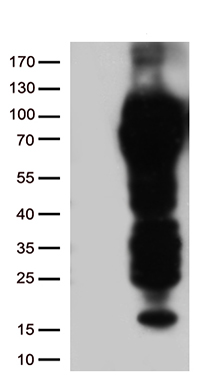CD5 Mouse Monoclonal Antibody [Clone ID: UMAB9]
CAT#: UM500009CF
Carrier-free (BSA/glycerol-free) CD5 mouse monoclonal antibody, clone UMAB9
Other products for "CD5"
Specifications
| Product Data | |
| Clone Name | UMAB9 |
| Applications | FC, IF, IHC, WB |
| Recommended Dilution | WB 1:500, IHC 1:100, IF 1:100, FLOW 1:100, IF 1:100 |
| Reactivities | Human |
| Host | Mouse |
| Isotype | IgG1 |
| Clonality | Monoclonal |
| Immunogen | Full length human recombinant protein of human CD5 (NP_055022) produced in HEK293T cell. |
| Formulation | Lyophilized powder (original buffer 1X PBS, pH 7.3, 8% trehalose) |
| Reconstitution Method | For reconstitution, we recommend adding 100uL distilled water to a final antibody concentration of about 1 mg/mL. To use this carrier-free antibody for conjugation experiment, we strongly recommend performing another round of desalting process. (OriGene recommends Zeba Spin Desalting Columns, 7KMWCO from Thermo Scientific) |
| Purification | Purified from mouse ascites fluids or tissue culture supernatant by affinity chromatography (protein A/G) |
| Conjugation | Unconjugated |
| Storage | Store at -20°C as received. |
| Stability | Stable for 12 months from date of receipt. |
| Predicted Protein Size | 54.4 kDa |
| Gene Name | Homo sapiens CD5 molecule (CD5), transcript variant 1, mRNA. |
| Database Link | |
| Background | CD5 is a cluster of differentiation found on a subset of IgM-secreting B cells called B-1 cells, and also on T cells. B-1 cells have limited diversity of theirB-cell receptor due to their lack of the enzyme terminal deoxynucleotidyl transferase (TdT) and are potentially self-reactive. CD5 serves to mitigate activating signals from the BCR so that the B-1 cells can only be activated by very strong stimuli (such as bacterial proteins) and not by normal tissue proteins. CD5 is a good immunohistochemical marker for T-cells. About 76% of T-cell neoplasms are reported to express CD5, and it is also found in chronic lymphocytic leukemia, hairy cell leukaemia, and mantle cell lymphoma cells. It is commonly lost in cutaneous T-cell lymphoma, and its absence can be used as an indicator of malignancy in this condition. The absence of CD5 in T cell acute lymphoblastic leukaemia, while relatively rare, is associated with a poor prognosis. |
| Synonyms | LEU1; T1 |
| Reference Data | |
| Protein Families | Druggable Genome, Transmembrane |
| Protein Pathways | Hematopoietic cell lineage |
Documents
| Product Manuals |
| FAQs |
Resources
| Antibody Resources |
{0} Product Review(s)
0 Product Review(s)
Submit review
Be the first one to submit a review
Product Citations
*Delivery time may vary from web posted schedule. Occasional delays may occur due to unforeseen
complexities in the preparation of your product. International customers may expect an additional 1-2 weeks
in shipping.






























































































































































































































































 Germany
Germany
 Japan
Japan
 United Kingdom
United Kingdom
 China
China













